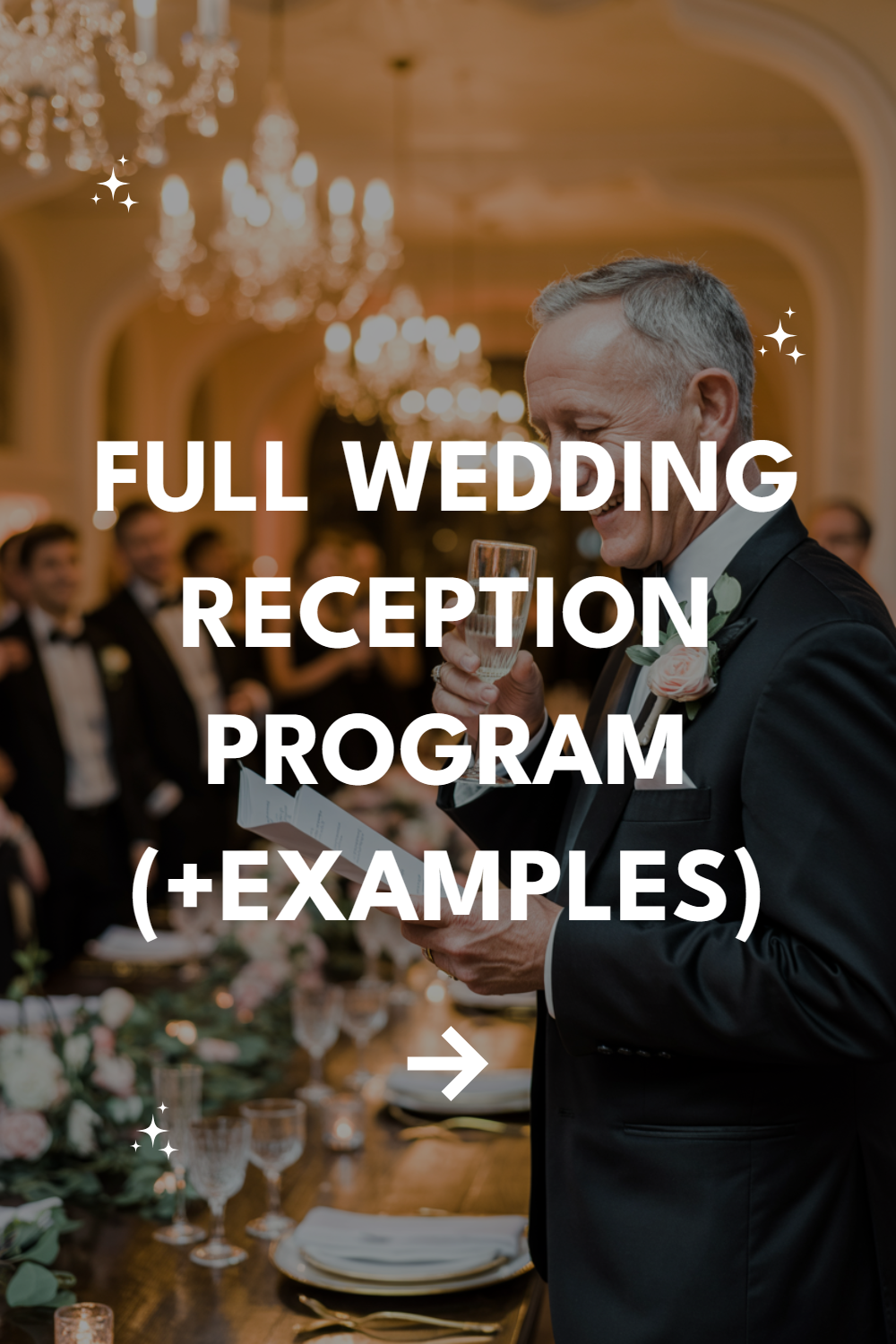Planning your wedding reception timeline can feel like orchestrating a small concert – except half the band is tipsy and Aunt Martha keeps asking when dinner starts.
The key to a smooth celebration lies in creating a structured program that flows naturally while leaving room for those beautiful, unplanned moments.
Reception Flow Fundamentals Explained
The Psychology Behind Timing
Wedding receptions work best when they mirror how people naturally socialize at parties. Guests arrive with different energy levels, appetites, and social batteries.
Some want to hit the dance floor immediately, while others need time to warm up with cocktails and conversation.
Your program should account for these natural rhythms. Early arrivals get cocktails and mingling time, while latecomers can still catch the important moments without feeling lost.
Essential Program Components
Every reception needs certain anchor points that give structure to the evening. These include the couple’s entrance, dinner service, speeches, and dancing. The magic happens in how you arrange and time these elements.
Think of your program as a playlist – you want peaks and valleys, not four hours of the same energy level. Balance high-energy moments with quieter ones, formal elements with casual fun.
Pre-Reception Preparation
Cocktail Hour Strategy
Cocktail hour isn’t just a holding pattern while you take photos. It’s your guests’ transition time from ceremony mode to party mode. Plan 60-90 minutes for this phase, especially if you’re doing a first look and most photos before the ceremony.
Provide substantial appetizers – not just cheese cubes and crackers. Hungry guests become cranky guests, and cranky guests don’t make for great party vibes.
Vendor Coordination Timeline
Your vendors need specific timing to execute flawlessly. The DJ needs to know when to start background music versus when to amp up the energy. Catering needs precise timing for food service to avoid cold entrees or wilted salads.
Create a detailed timeline for vendors that includes buffer time. If speeches are scheduled for 7:30, tell your caterer they start at 7:45. Trust me on this one.
Reception Program Examples
Traditional Formal Reception
5:30-6:30 PM: Cocktail Hour
Guests arrive, enjoy signature cocktails and appetizers while you finish photos. Background music keeps energy pleasant but conversational.
6:30-6:45 PM: Grand Entrance
Wedding party and couple entrance with upbeat music. Keep introductions brief – people are hungry and want to sit down.
6:45-7:45 PM: Dinner Service
Seated dinner with background music. This is prime conversation time, so keep music volume low enough for table talk.
7:45-8:15 PM: Speeches
Welcome, best man, maid of honor, and parents. Limit to four speakers maximum – seriously, nobody wants to hear from your college roommate’s boyfriend.
8:15-8:30 PM: First Dance & Parent Dances
Traditional dances while guests finish dessert and coffee. Perfect transition moment before opening the dance floor.
8:30 PM-Midnight: Dancing & Celebration
Open dance floor with DJ mixing crowd favorites. Include anniversary dance, bouquet toss, or other traditions as desired.
Casual Modern Reception
4:00-5:00 PM: Cocktail Reception
Immediate post-ceremony celebration with drinks and heavy appetizers. More relaxed timing allows for natural mingling.
5:00-5:15 PM: Couple’s Entrance
Simple entrance, maybe just the couple without wedding party fanfare. Keep it low-key and authentic to your style.
5:15-6:00 PM: Dinner & Toasts
Family-style or buffet dinner with speeches woven throughout the meal. More organic feel than formal sit-down timing.
6:00-6:15 PM: Cake Cutting
Earlier cake cutting means better photos with natural light and gives non-dancers a sweet ending if they want to leave.
6:15-10:00 PM: Dancing & Games
Extended dance time with lawn games, photo booth, or other interactive elements. Flexible ending based on crowd energy.
Brunch Reception
11:00 AM-12:00 PM: Arrival & Mimosas
Guests arrive to champagne, coffee, and light pastries. Morning celebrations have a naturally relaxed vibe.
12:00-12:15 PM: Welcome & Seating
Brief welcome, maybe a blessing or toast, then invite guests to brunch buffet. Keep formality minimal.
12:15-1:30 PM: Brunch & Conversation
Extended meal time with rotating courses. Brunch crowds love to linger over food and coffee.
1:30-2:00 PM: Speeches & Cake
Shorter speech segment followed by cake cutting. Morning crowds have less patience for long programs.
2:00-4:00 PM: Dancing & Celebration
Upbeat music and dancing. Brunch receptions often end earlier, which works perfectly for guests with kids.
Common Timing Mistakes to Avoid
The Dinner Rush Disaster
Starting dinner service at 6:00 PM sounds reasonable until you realize half your guests haven’t eaten since breakfast. Hangry wedding guests are not your friends. If your ceremony ends at 4:30, plan cocktail hour until 5:30, then dinner.
Coordinate with your caterer about realistic service timing. A plated dinner for 150 people takes longer than you think, especially if Uncle Bob decides to give an impromptu speech mid-service.
Speech Overload
Limiting speeches saves your reception from becoming a roast that never ends. Four speakers maximum, three minutes each, with a designated person to gently wrap up the chatty ones.
Position speeches strategically – not right when dinner arrives, not when people are ready to dance. The sweet spot is usually between dinner and dancing, when people are satisfied but not yet restless.
Dance Floor Timing
Opening the dance floor too early means empty space and awkward energy. People need time to eat, drink, and socialize before they’re ready to bust out their moves.
Conversely, waiting too long kills momentum. If your crowd is ready to dance at 8:00 but you’re still doing formalities at 9:30, you’ve lost them.
Creating Your Personal Timeline
Know Your Crowd
Your college friends will party until 2 AM, but your grandparents might be ready to leave after dinner. Design your program around your actual guest list, not some theoretical perfect crowd.
Consider the age range, family dynamics, and general party preferences of your people. A crowd full of young professionals might love a late-night dance party, while a family-heavy guest list might prefer earlier timing.
Seasonal Considerations
Summer weddings can handle later timing and outdoor elements. Winter celebrations might need earlier start times and more indoor backup plans.
Weather affects everything from cocktail hour length to dancing energy. Plan accordingly and have realistic expectations about outdoor elements.
Venue-Specific Factors
Some venues have noise restrictions, mandatory end times, or specific service requirements. Work within these constraints rather than fighting them.
Destination weddings need different timing than hometown celebrations. Guest travel fatigue, local customs, and unfamiliar venues all impact your ideal timeline.
Flexibility and Final Thoughts
The best wedding programs feel effortless because they’re well-planned but not rigid. Build in buffer time, communicate clearly with vendors, and designate someone to keep things moving who isn’t you.
Your timeline is a framework, not a prison sentence. If speeches run long because your dad is telling hilarious stories, roll with it. If your crowd wants to keep dancing past the planned end time, celebrate that energy.
The goal is a great party, not perfect adherence to a schedule you created months ago.


